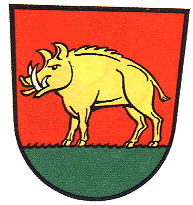Ebersbach an der Fils: Difference between revisions
Jump to navigation
Jump to search
Knorrepoes (talk | contribs) No edit summary |
Knorrepoes (talk | contribs) m (Text replace - "[[Literature" to "{{media}} [[Literature") |
||
| Line 18: | Line 18: | ||
====Origin/meaning==== | ====Origin/meaning==== | ||
The arms show the canting boar (Eber), which has been used as a symbol for the town for many centuries. All seals since 1489 show the boar. The colours of the arms are known since 1535. The composition of the arms thus never changed, but the shape and position of the boar changed rather often. The present arms date from 1937 and are based on the oldest seal. | The arms show the canting boar (Eber), which has been used as a symbol for the town for many centuries. All seals since 1489 show the boar. The colours of the arms are known since 1535. The composition of the arms thus never changed, but the shape and position of the boar changed rather often. The present arms date from 1937 and are based on the oldest seal. | ||
{{media}} | |||
[[Literature]] : Gönner and Bardua, 1966 | [[Literature]] : Gönner and Bardua, 1966 | ||
Revision as of 21:00, 8 July 2014
| Heraldry of the World Civic heraldry of Germany - Deutsche Wappen (Gemeindewappen/Kreiswappen) |
EBERSBACH AN DER FILS
State : Baden-Württemberg
District (Kreis) : Göppingen
Additions : 1974 Rosswälden; 1975 Bünzwangen, Weiler ob der Fils
Official blazon
In Rot auf grünem Boden stehend ein goldener Eber mit silbernen Hauern.
Origin/meaning
The arms show the canting boar (Eber), which has been used as a symbol for the town for many centuries. All seals since 1489 show the boar. The colours of the arms are known since 1535. The composition of the arms thus never changed, but the shape and position of the boar changed rather often. The present arms date from 1937 and are based on the oldest seal.
Contact and Support
Partners:
Your logo here ?
Contact us
© since 1995, Heraldry of the World, Ralf Hartemink 
Index of the site
Literature : Gönner and Bardua, 1966











